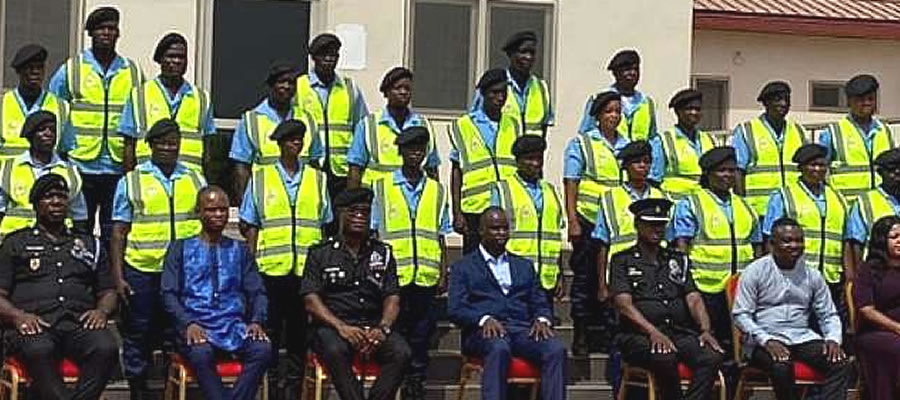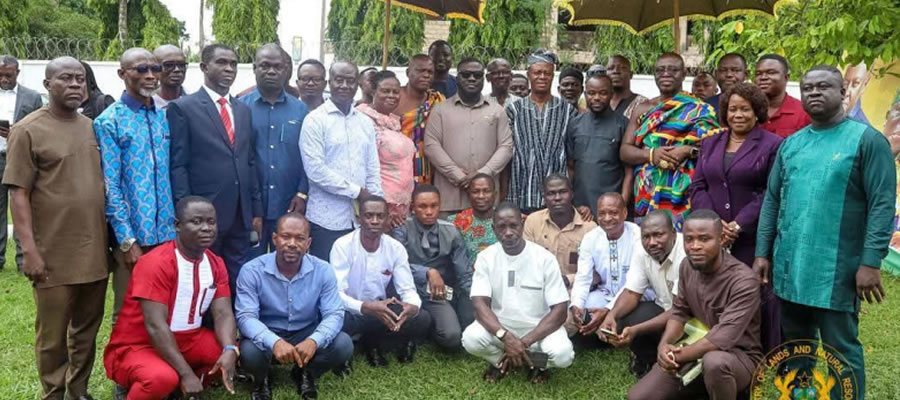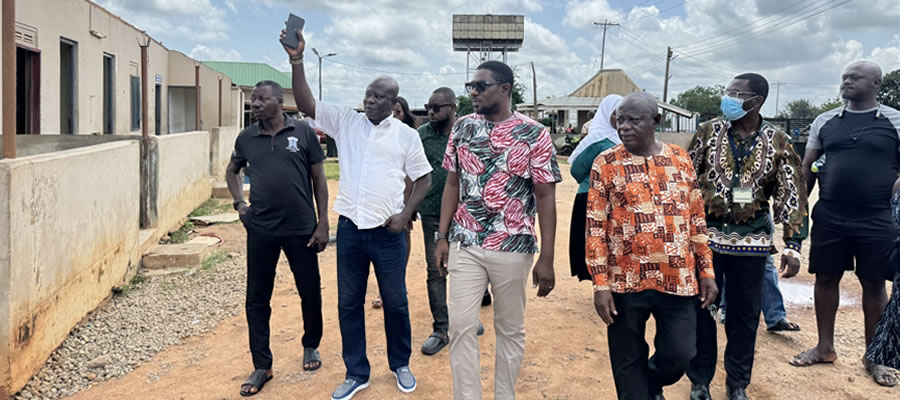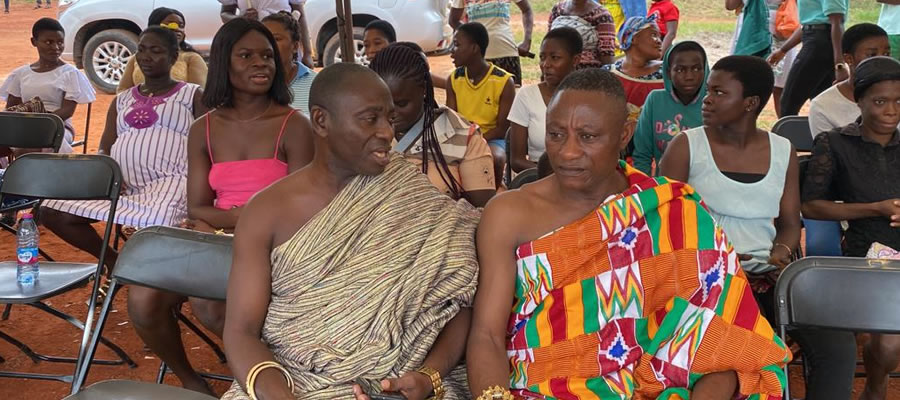

Location and Size
The Atwima Nwabiagya Municipal lies approximately between latitude 6o 32’N and 6o 75’N and between longitude 1o 45’ and 2o 00’ West. It is one of the 30 political and administrative districts in Ashanti Region.
The district is situated in the western part of the region and shares common boundaries with Ahafo Ano South and Atwima Mponua Districts (to the West), Offinso Municipal (to the North), Amansie–West and Atwima Kwanwoma Districts (to the South), Kumasi Metropolis and Afigya Kwabre Districts (to the East). It covers an estimated area of 294.84 sq km. The district capital is Nkawie.
The main highway corridor from the Ashanti Region to the Western Region goes through our district.
Topography and Drainage
The district has an undulating topography. The lands have average heights of about 77 metres above sea level. The high lands have gentle to steep slopes. The highest points in the district can be found in the Barekese and Tabere areas. There are a number of wider valleys with no evidence of stream flow. These valleys provide opportunities for rice, sugarcane and vegetable cultivation.
The Offin and Owabi are the main rivers which drain the surface area of the district. Two major dams, Owabi and Barekese have been constructed across the Owabi and the Offin rivers respectively. These dams supply pipe borne water to the residents of Kumasi and its environs, including some settlements in the district.
Farming activities are carried out close to the banks of some of the rivers and streams in the district, which results in eutrophication and siltation of the rivers required to protect and conserve vegetation of the district, especially around water bodies.
Climate
The District lies within the wet semi-equatorial zone marked by double maximum rainfall ranging between 170cm and 185cm per annum. The major rainfall season is from Mid-March to July and minor season is between September and mid-November. Rainfall in the district is not distributed throughout the year. It is also not very reliable. It is therefore not safe to entirely practice rain fed agriculture. Agriculture within the district must incorporate soil and water conservation measures to ensure all year crop cultivation and good yield.
Temperature is fairly uniform ranging between 27ºC (August) and 31ºC (March). Mean relative humidity is between 87 and 91 percent. The lowest relative humidity usually occurs in February/April.
Vegetation
The vegetation found in the district is predominantly the semi-deciduous type. The vegetation type has largely been disturbed by human activities (logging, farming, bush fires etc), thus, depriving it of its original valuable tree species (eg odum, sapale), fauna and other forest products.
There are some pockets of forest reserves available in the district. These include the Owabi Water Works Forest Reserves and Barekese Water Works Forest Reserve, which serve as water shed protection for the Ofin and Owabi rivers. In addition part of the Gyemena Forest Reserve is located in the district.
These forest reserves have been encroached upon by farmers, sand winners and illegal chain saw operators. These practices continue to threaten the lives of the Offin and Owabi Rivers, and the Barekese and Owabi reservoirs. Public education, proper enforcements of existing laws and other conservation interventions are visible evidence of the adverse effects of climate change in the Atwima Nwabiagya Municipal. These include changes in rainfall patterns, storms, altered patterns of agriculture and associated crop failures, intermittent flow of streams, and increased cases of diseases (especially malaria), among others. These changes are threats to the achievement of the development priorities of the district.
There is therefore the need to reduce the vulnerability of natural and human systems to climate change effects, and also reduce the emission of greenhouse gases or enhance the removal of these gases from the atmosphere. Development effort of the district must therefore be compatible with this aim. Reduction in indiscriminate solid and liquid waste disposal, improvement in drainage systems, reduction in haphazard erection of physical structures, reduction in deforestation and degradation of water bodies would go a long way to enhance natural and human adaptation to climate change effects.
Soils
The district is underlain by the Lower Birimian rocks, which consist of phyllites, greywaches, achists and gneiss, and the Cape Coast Granite. Both the Lower Birimian and the Cape Coast Granite are of considerable economic importance since they do bear Gold, and good clay deposit for ceramics and brick making. The Cape Coast Granite is a good potential for the building and road construction industry.
The District Assembly should continue to provide conducive environment for the full-scale and sustainable exploitation of these rocks, which are mostly found around Asakraka, Nerebehi, Mfensi, Tabere, Ntensre and Barekese, to create jobs and also provide sources of revenue for the district’s development.
The predominant soils in the district are the Kumasi-Asuansi/Nta-Ofin Compound Associations and the Bekwai- Nzema/Oda Complex Associations. They are suitable for cultivation of tree and arable crops such as cocoa, citrus, oil palm, mangoes, guava, avocado, maize, cassava, yams, cocoyam, plantain, pawpaw, groundnuts pineapple and ginger. The valley bottom soils are good for the cultivation of rice, sugarcane and vegetable.
Residential activities and sand winning have currently taken most of these good agriculture lands. Proper land use planning and zoning are required to protect soils which are suitable for agriculture.
Climate Change
Increased concentration of greenhouse gases (i.e. carbon dioxide, water vapour, methane, nitrous oxide, etc.) in the atmosphere has resulted in increased global warming, the impacts of which are being felt both globally and locally. There is and streams. Streams which flow through major settlements have also been polluted, as a result of the discharge of liquid and solid waste into them. Measures are required to properly manage the water bodies in the district to promote their sustainability.
Geology and Minerals
The district is underlain by the Lower Birimian rocks, which consist of phyllites, greywaches, achists and gneiss, and the Cape Coast Granite. Both the Lower Birimian and the Cape Coast Granite are not of considerable economic importance since they do not bear Gold and Bauxite. However, the rocks (Especially the Lower Birimian) consist of good clay deposit. The Cape Coast Granite is a good potential for the Construction Industry.
It is the hope of the District Assembly that the full-scale exploitation of these rocks, which are mostly found around Tabere and Barekese, will create jobs in the district and also provide the much-needed revenue for the district’s development.
The District’s proximity to the Kumasi Metropolis has a number of advantages, which requires attention. These include the following:
Some of the settlements serves as dormitory to Kumasi and therefore receives fast rate of physical development for residential and commercial purposes. As a result land value in these areas has increased thereby increasing the incomes of landowners.
The increasing rate of property development in these areas is a potential for increased revenue generation by the District Assembly.
Kumasi is a big potential market for variety of agricultural produce. Atwima Nwabiagya Municipa is an agrarian district and should therefore take advantage of this potential market to diversify and increase production.
There are also some disadvantages associated with the location of the district. These include the following:
Pressure on land and its associate high cost
Good Agricultural lands are gradually being lost to urban development
The district is a receptor of the spill over of the Metropolitan crimes and other social vices
Increased level of waste generation
Increased unemployment for the unskilled labour due to loss of Agricultural lands for residential and ancillary physical development.
Measures are therefore required to exploit the advantages and to manage the disadvantages associated with the district’s location
Condition of the Physical Environment
Concerns over the impact of socio-economic development on the environment have become quite topical these days. There is an increased rate of environmental degradation. Environmental issues have therefore become very important in planning. The description below highlights the state of the physical environment of the district, the main environmental concerns and their impact on development.
Even though the District is endowed with natural forest, there has been high rate of its exploitation through human activities such as bush fires, fire wood extraction, livestock, lumbering, farming etc. The net effect of these activities has been the reduction in vegetation cover, which also has adverse effects on the climate. The forest of the district, which has been the major source of timber, has gradually lost its once enviable vegetative cover.
Lumbering activities by large timber firms can be found around Ataase, Wurapong, Ntabaanu, Kutugin etc. The activities of these timber contractors in the district have had negative effects on the environment. The forests are also used for crop farming and this has also added to the degradation of the natural environment by reducing the forest from primary to secondary. Effort has to be made to intensify re-aforestation and encourage environmentally sustainable methods of farming and lumbering.
Conditions of the Built Environment
The 2000 Population and Housing Census indicate that the District has 11,156 houses. Most houses in the rural part of the District are of poor quality. Some of the houses (in especially Asakraka, Abira, Fufuo, etc.) have their foundations exposed thereby exposing the inhabitants to the risk of losing their houses and their lives. There is general lack of maintenance culture in the settlement and the situation of houses in most settlement is so deplorable that it will require huge financial resources to salvage them. Most of the houses are compound type, which constitute about 52% of the housing stock.
Open dumping is the main method of refuse disposal. There are some heaps of refuse in the district and these are found mainly in the urban settlements, of Abuakwa, Nkawie, Barekese and Asuofua. The Assembly is making efforts to clear these heaps of refuse, but due to poor waste management practices by the communities/Households and Assembly’s weak capacity to manage refuse on regular basis the volume of refuse generated in these settlement, it is common occurrence to see huge volume of refuse being piled up.
Pit latrine is the dominant method of liquid waste disposal. In the rural communities, there is usually one pit latrine for the whole community. In the urban settlements public toilet (KVIP) and Vault chamber type are prevalent. Only few households in the district, both rural and urban have household toilet facilities. In order to encourage household to put up their own places of conveniences, the Assembly is currently subsiding the cost of construction of these household toilets. It will be necessary to improve on the housing quality and waste management in the district’s planning efforts.
The peri-urban enclave of the District has witnessed a lot of development activities Abuakwa for instance is the fastest growing town in the District and with the upsurge of construction activities, Sand Winning has become a problem. Sand is mined at Mim, Bowesango, Sepaase, Nkawie etc. The sand winners usually create gallies, which become breeding grounds for mosquitoes. The Assembly’s efforts to get these sand contractors to reclaim the land have not yielded any fruits.
Some of the key environmental development problems include;
Poor sanitation in urban areas
High level of environmental degradation resulting from farming, illegal lumbering and sand winning
Inadequate capacity to manage the fast rate of development in the Urban/Peri-Urban areas
Poor farming practices such as bush burning and use of chemicals for fishing.
High level of erosion in settlements
Poor drainage systems
Poor access roads within settlements
Inability of the Assembly to solve the Development Problems identified has far reaching consequences on the environment. For instance the main method of refuse disposal is open dumping and almost all the communities have dumping sites which usually develops into mountains over time. Inability to put measures to deal with this situation will result in the spread of cholera. Again indiscriminate felling of tress and poor farming practices destroy the forest and the eco-system.
Date Created : 11/24/2017 3:30:30 AM












 facebook
facebook
 twitter
twitter
 Youtube
Youtube
 +233 593 831 280
+233 593 831 280 0800 430 430
0800 430 430 GPS: GE-231-4383
GPS: GE-231-4383 info@ghanadistricts.com
info@ghanadistricts.com Box GP1044, Accra, Ghana
Box GP1044, Accra, Ghana